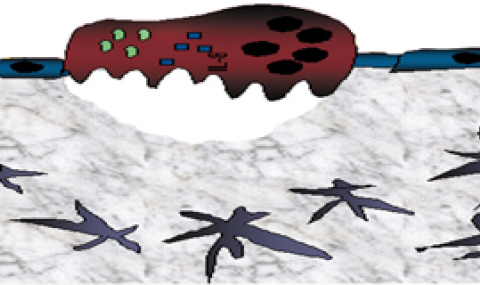Hematopoietic stem cell/progenitor (HSCP) transplantation (HSCT) is routinely used for the treatment of cancer and inborn hematopoietic defects. The bone marrow (BM) microenvironment (ME) is a major regulator of hematopoietic function and fate. Clinical data supports osteoblastic regeneration after HSCT despite the inability of BM mesenchymal stem cells (BM-MSC) to engraft. Therefore, understanding the hematopoietic-dependent mechanisms controlling ME mesenchymal regeneration is expected to provide molecular targets for intervention in the context of HSCT. Hematopoietic connexin-43 (H-Cx43) mediates HSCP survival and efficient blood formation by scavenging damaging excess reactive oxygen species (ROS) through transfer to BM mesenchymal stromal cells (BM-MSC) after chemotherapy, preventing lethal hematopoietic failure (Taniguchi-Ishikwawa E et al., PNAS 2012), while the expression of Cx43 on BM-MSC regulates CXCL12 secretion and HSCP homeostasis (Schajnovitz A et al., Nat. Immunol., 2011). Since Cx43 is expressed in mitochondria, we hypothesized that H-Cx43 mediated ROS transfer upon stress depends on hematopoietic mitochondria transfer and uptake by the BM-MSC. We created chimeric mice by transplanting Vav1-CreTg/-, Cox8 mitochondrial localization signal-Dendra2Tg/- wild-type (mDendra2/WT) or Cx43fl/fl(mDendra2/Cx43) HSCP to lethally irradiated, congenic WT mice and assessed the recovery of stromal cell regeneration via transfer of mitochondria to BM-MSC. H-Cx43chimeric mice have delayed lympho-hematopoietic recovery after irradiation or chemotherapy which can be reversed by restoration of hematopoietic Cx43 expression. H-Cx43chimeric mice exhibit decreased (~60-80%) and delayed colony-forming-unit-fibroblast (CFU-F) and osteoblast (CFU-Ob) regeneration and hematopoietic recovery. The delayed hematopoietic response in H-Cx43chimeras associated with ~40% reduction in mitochondrial transfer from HSCP to Lin-/CD45-/PDGFRα+/Sca1- BM stromal cells (MSC/P). Reverse transplantation experiments indicate that stromal Cx43 is dispensable for mitochondrial transfer from BM stroma to HSCP. Impaired mitochondrial uptake in H-Cx43chimeras associated with ~30-40% decreased mitochondrial ROS (mROS), membrane potential (MMP) and proliferation (assessed by in vivo BrdU uptake) of recipient MSC/P, suggesting that the transferred mitochondria reprogram the recipient mesenchymal progenitor metabolism. Defects of mitotransfer from H-Cx43HSCP to BM MSC/P and in recipient BM MSC/P mitochondrial activity were recapitulated in in vitro co-cultures. Interestingly, intracellular [ATP] is upregulated (~2 fold) in MSC/P from chimeric H-Cx43BM that received donor-derived mitochondria, as compared to donor mitochondria containing MSC/P from WTchimeras. Hemichannel opening causes loss of ATP, we therefore speculated that ATP released from MSC/P upon irradiation and transplantation is uptaken by HSPC, activating mitochondrial transfer as part of BM regeneration. Forced glycolysis-dependent restoration of [ATP] in MSC/P but not in HSCP enhances transfer of mitochondria from HSCP to MSC/P, suggesting that BM stromal [ATP] is an irradiation-responsive positive regulator of mitochondria transfer. Hemichannel-derived exogenous ATP suppresses AMPK activation, which regulates cellular metabolic homeostasis by modulating mitochondrial ROS, mitochondria dynamics and the fate of mitochondria. We found that MSC/P recipient of H-Cx43 mitochondria have increased AMPK activity as assessed by increased phosphorylation (~2-fold) of its downstream effectors ULK1 and ACC when compared with MSC/P recipient of H-WT mitochondria, whereas MSC/P containing no donor-derived mitochondria from either chimeric mice are insensitive to the effect of Cx43 deficiency. In vivo administration of the AMPK inhibitor BML-275 dramatically increased the mitochondria transfer from HSCP to MSC/P in WT and H-Cx43chimeras, and completely restores the negative effect of H-Cx43 deficiency on mesenchymal and hematopoietic regeneration. Our data indicate that hematopoietic mitochondrial Cx43 is required to control both mitochondrial transfer and BM ME energetic balance and regeneration after myeloablative irradiation. Our data suggests that hematopoietic Cx43 and mitotransfer may be targets for ex vivo manipulation and transplantation protocols for bone disease therapy.

Dynamic Networking between Stem Cells & Bone Marrow Microenvironment


